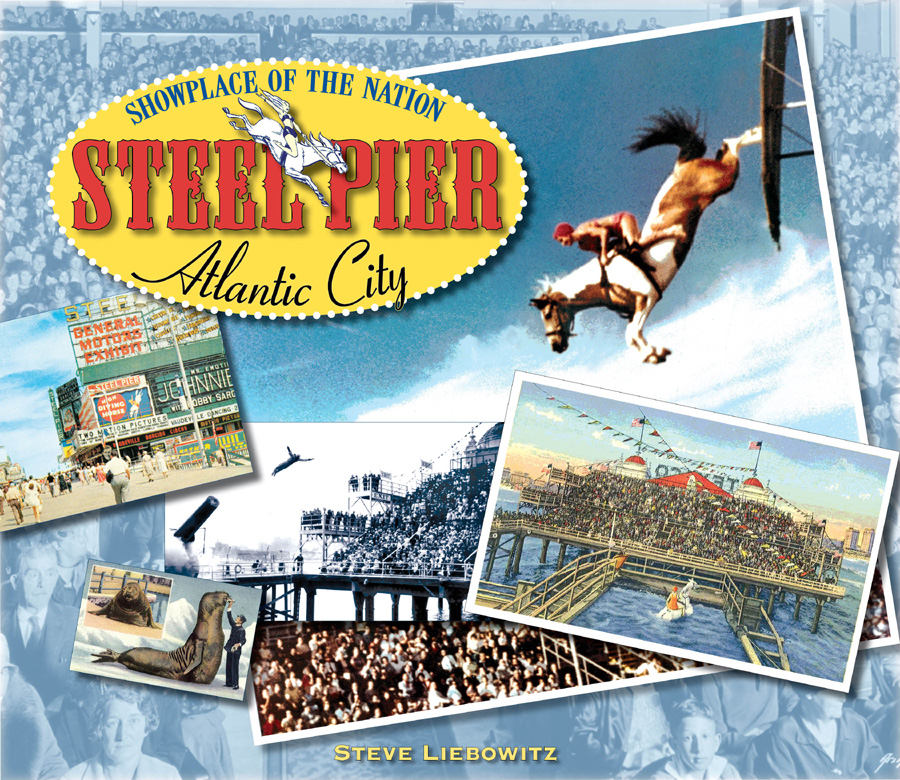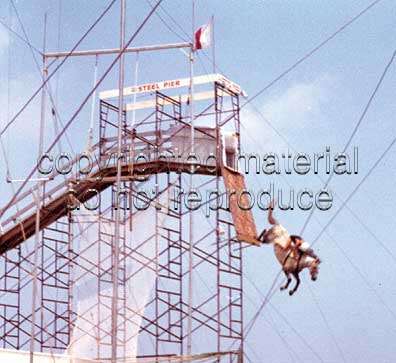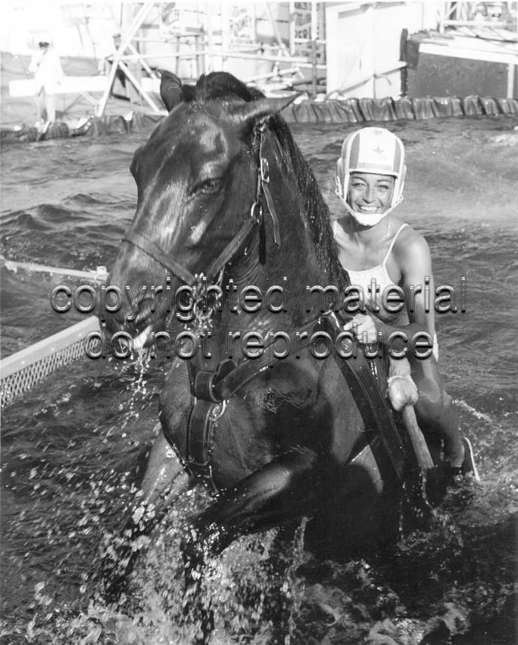“Steel Pier, the ‘Capital of Americana,’ was an entertainment destination never to be replicated.
It deserves a book of its own!”
-- Vicki Gold Levi, author of Atlantic City: One Hundred Twenty-Five Years of Ocean Madness
and a historical picture editor, photography curator, and co-founder of the Atlantic City Historical Museum.

|
Steel Pier, Atlantic City
Showplace of the Nation By Steve Liebowitz |
|||||
|
2010 • Regional Book |
|||||
of Steel Pier

of STEEL PIER

TIMELINE

Steel Pier page

263 pp., 227 Illustrations
ISBN-13 978-1-59322-036-5
$39.00

From former Diving Horse rider Sarah Detwiler Hart (wife of the late Gene Hart - the voice of the Philadelphia Flyers and former Steel Pier employee)
"They went when they were ready. I can’t say the groom would not try to encourage the horse a little bit by gently nudging or pushing, but he wouldn’t dare do anything drastic. That would have upset me to no end. I wouldn’t want to be on a horse that was agitated. My life depended on that horse doing that in a calm way, so there was no electrical devices or trap doors or anything like that during my time.
Lorga (another diving horse) did take a long time. I remember Lorena Carver saying 'Come,' with carrots in her hand. But you waited. Sometimes it was five minutes.
I had a horse named Gamal that would run up there and you were lucky you got on the horse. A couple times I was just barely on and I had to really be quick acting to get my position and hold on. We had little side handles and a harness. There was no stirrup; I was bareback. I used my knees to keep my weight back, so when we hung there momentarily, I wouldn’t slip over the head. That would have been disastrous. That happened once in training and it was a miracle I didn’t get a scratch.
There was a thick roll of some kind of rubber padding that was somehow connected to this leather that was strapped under the belly of the horse like a saddle, but not that far back. I would be seated in back of that roll, which looked like the horse had a collar on. Then it had these two leather horizontal straps large enough for your hands to grab them, so I was holding on to this. Otherwise, it was up to me to use my legs. And the reason for that roll and those handles was so that I wouldn’t go over the horse’s head.
The horse would hang there for a little while before kicking off. My job was to use my timing correctly and tuck in there real tight by his neck and tuck my chin down, and ride as close as I could to the horse.
And then if the horse would go down in a way maybe a little too steep, that horse would roll, and then I would be under him. That’s when you get hurt because there’s thrashing legs.
The tank was between ten and fifteen feet deep and about twenty feet across, not really large. It wasn’t real deep but was lined with foam rubber with a silver, tough-type of material, so when the horse hits, he hits soft. The water was ample enough to break the speed and the weight. There was a very tough fiber matting for the incline for the horse to walk out of, and water never affected it.
I would ride the horse until he got out of the tank. Lorena Carver would be standing on the stage of the tank and the horse knew to go to her, get his reward, and the blanket was thrown on quickly. That was the end of the act.
You [the customers] could go in the stalls, along the walkway towards the end of the Pier and in front of the Ballroom, and see the horses through glass panels and how they were kept and fed. They were very well kept. They would ride the horses on the beach in the morning and they loved to go in the water and run along the waves.
We didn’t keep them if they didn’t like the water. I would have noticed if there had been anything unkind because I love animals. They were never in any way hurt or disrespected. In fact, they were taken care of better than the riders were! The ASPCA gave us plaques of approval that were always on the dressing room wall. When Gene was in the show with me he’d bring me a towel, but the horse was the one that got the blanket! The horse was the star."
"The Atlantic City Press gave its readers some background on the Diving Horse act in June 1936:
Doc Carver’s daughter Lorena trains and owns all of the horses. She said that it takes an average of three years required to train a naturally talented horse. Gordonel, however, one of three she now trains, learned so rapidly that he was with a rider after thirty-two days. John the Baptist is 27 years old and is eager as ever for his daily stunts before applauding throngs.
The horses are trained and kept in the winter at Carver’s ranch in Quakertown, Pennsylvania, while new horses are raised at her other ranch in California."
"Quarter Horses were used because they were smaller than Thoroughbreds. There was a white Arabian, John the Baptist, and a pinto horse named Red Lips, and Scheherazade, who couldn’t swim that well. Klatawa, which means 'so long' in the Chinook language (Indian), was a show-off who loved big crowds, pawing and tossing his head for them but sulking if it was rainy and the audience was small. He once backed all the way down the ramp when he didn’t feel like jumping.
'The act wasn’t cruel to the horses because most of them liked to jump. You couldn’t force them. You had to wait until the horse was ready to jump,” Arnette claimed in the New York Times in 1997. 'Once you were on the horse, there really wasn’t much to do but hold on. The horse was in charge.'"


e-mail info@down-the-shore.com • phone 609-978-1233 • fax (609) 597-0422
Copyright © 2012 Down The Shore Publishing Corp. The words "Down The Shore" and logo are a registered U.S. Trademark.